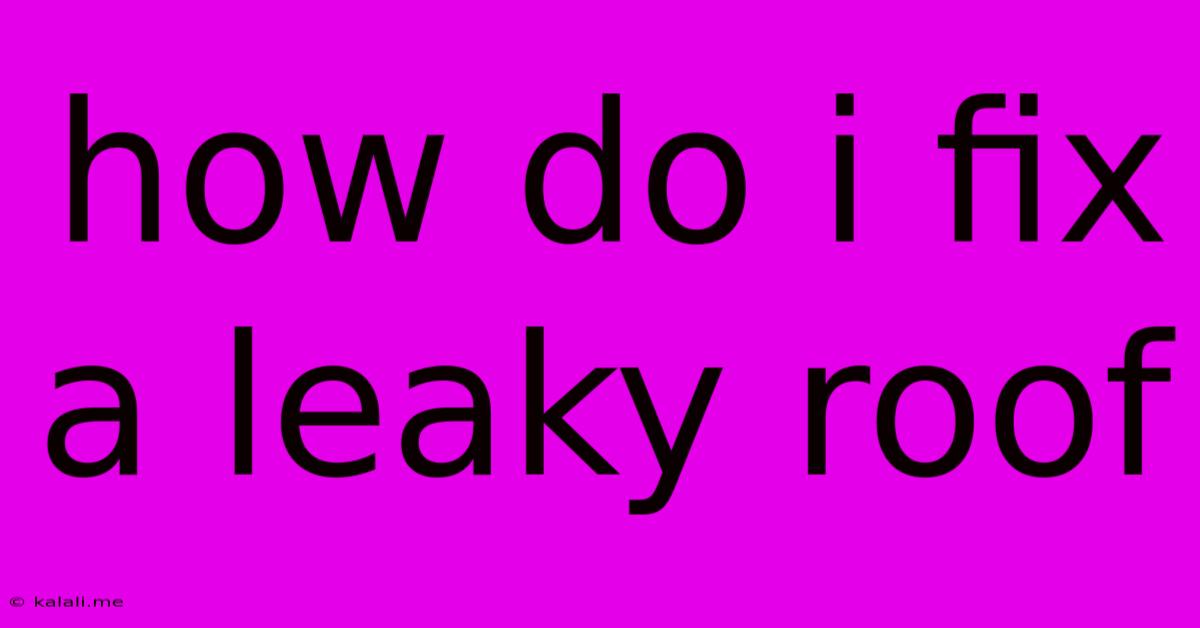How Do I Fix A Leaky Roof
Kalali
May 30, 2025 · 4 min read

Table of Contents
How Do I Fix a Leaky Roof? A Comprehensive Guide
A leaky roof is a homeowner's nightmare, causing water damage, mold growth, and potential structural problems. This comprehensive guide will walk you through identifying the leak, choosing the right repair method, and completing the fix, empowering you to tackle this common home issue. Whether you're dealing with a minor drip or a major leak, understanding the process will save you time, money, and frustration.
Identifying the Source of the Leak
Before you grab your tools, accurately locating the leak is crucial. This often involves more than just finding the water stain on your ceiling.
- Inspect the Attic: Start by carefully examining your attic. Look for water stains on the roof sheathing, damp insulation, or visible water dripping. This helps pinpoint the general area of the leak. A flashlight can be invaluable in dimly lit attics.
- Check the Exterior: Go outside and inspect the roof from all sides. Look for missing or damaged shingles, cracked flashing around chimneys or vents, and gaps in the roofline. A close examination during and after rainfall will be most helpful.
- Use a Garden Hose (with caution): If you've narrowed it down to a specific area, carefully use a garden hose to gently simulate rainfall on the suspected area. Have someone inside to watch for water appearing. This method is best used on a dry day.
- Professional Inspection (When Needed): For complex or persistent leaks, a professional roofing inspection might be necessary. They have the expertise to locate even hidden leaks and recommend the best course of action.
Choosing the Right Repair Method
The repair method depends on the severity and cause of the leak. Minor issues can often be handled by homeowners, while major repairs often require professional assistance.
- Minor Leaks (Shingle Damage): Small cracks or missing granules on asphalt shingles can often be patched using roofing cement or specialized shingle repair kits. Ensure the surface is clean and dry before application.
- Flashing Issues: Damaged flashing around chimneys, vents, or skylights often requires replacing the entire flashing. This is a more involved task and might require specific tools and skills.
- Larger Holes or Damage: Significant holes or extensive damage usually require replacing sections of the roofing material. This is best left to professional roofers who have the expertise and specialized tools for this type of repair.
- Underlayment Problems: If the leak originates from beneath the shingles, the underlayment (a waterproof membrane) might be damaged. This often requires significant repair and might necessitate professional assistance.
Essential Tools and Materials
Having the right tools makes the job easier and safer. The specific tools will vary based on the repair method, but some essentials include:
- Safety Gear: Hard hat, safety glasses, and work gloves are crucial for roof work.
- Ladder: A sturdy ladder that extends well above the roofline is essential for safe access.
- Roofing Cement: For patching small holes and sealing cracks.
- Shingle Repair Kit: For repairing minor shingle damage.
- Utility Knife: For cutting shingles or flashing.
- Caulk Gun: For applying roofing cement or sealant.
- Flashing: For repairing or replacing damaged flashing.
- Roofing Nails: For securing new shingles or flashing.
Temporary Fixes for Emergency Situations
If you have a sudden and significant leak during a storm, temporary fixes can prevent further damage until professional repairs can be scheduled.
- Tarps: Cover the affected area with a heavy-duty tarp, securing it with weights or clamps. This is a temporary solution to prevent water infiltration.
- Buckets: Place buckets to catch leaking water, protecting your interior from damage.
When to Call a Professional
While many minor roof repairs are DIY-friendly, some situations demand professional assistance:
- Extensive Damage: Large holes, missing shingles over a wide area, or significant underlayment damage.
- Complex Repairs: Repairing or replacing flashing, dealing with complicated roof designs, or working with specialized roofing materials.
- Safety Concerns: If you're uncomfortable working at heights or lack the necessary experience.
Addressing a leaky roof promptly prevents escalating problems. By carefully identifying the leak, choosing the appropriate repair method, and following safety precautions, you can successfully tackle this common home maintenance challenge, protecting your home's integrity and your peace of mind. Remember, safety always comes first – if in doubt, call a professional.
Latest Posts
Latest Posts
-
How Do Particles Or Parts Interact Magnitism
May 31, 2025
-
Knocking It Out Of The Park
May 31, 2025
-
Match External Display Color To Macbook Pro
May 31, 2025
-
Error Cannot Open Git Fetch Head Permission Denied
May 31, 2025
-
How To Hide A Dead Body
May 31, 2025
Related Post
Thank you for visiting our website which covers about How Do I Fix A Leaky Roof . We hope the information provided has been useful to you. Feel free to contact us if you have any questions or need further assistance. See you next time and don't miss to bookmark.